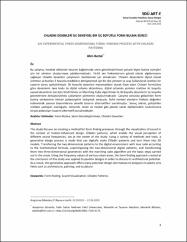| dc.contributor.author | Battal, Alim | |
| dc.date.accessioned | 2023-09-04T13:58:24Z | |
| dc.date.available | 2023-09-04T13:58:24Z | |
| dc.date.issued | 2023 | en_US |
| dc.identifier.citation | BATTAL, Alim. "Chladni Desenleri ile Deneysel Bir Üç Boyutlu Form Bulma Süreci". Art-e Sanat Dergisi, 16.31 (2023): 1-13. | en_US |
| dc.identifier.uri | https://dergipark.org.tr/tr/pub/sduarte/issue/78416/1274158 | |
| dc.identifier.uri | https://hdl.handle.net/11352/4646 | |
| dc.description.abstract | Bu çalışma, hareket etkisinde tasarım bağlamında sesin görselleştirilmesi yoluyla biçim bulma süreçleri
için bir yöntem oluşturmaya odaklanmaktadır. Farklı ses frekanslarının görsel olarak algılanmasını
sağlayan Chladni desenleri çalışmanın merkezinde yer almaktadır. Chladni desenlerini dijital olarak
üretmek ve bunları 3 boyutlu modellere dönüştürmek için bir dizi yöntem ve araç kullanılarak üretken bir
tasarım süreci geliştirilmiştir. İki boyutlu desenleri matematiksel olarak ifade eden Chladni formülüne
göre desenlerin Java kodu ile dijital ortama aktarılması, dijital ortamda yeniden üretilen iki boyutlu
sayısal desenlerin üst üste bindirilmesi ve Marching Cube algoritması ile iki boyutlu desenlerin üç boyutlu
geometrilere dönüştürülmesi çalışmanın yöntemini oluşturmaktadır. Çalışma sonunda geliştirilen form
bulma yönteminin mimari potansiyelini tartışmak amacıyla, farklı kentsel alanların frekans değerleri
kullanılarak pavyon tasarımlarına yönelik tasarım alternatifleri sunulmuştur. Sonuç olarak, geliştirilen
üretken yaklaşım aracılığıyla, mimarlık, resim ve heykel gibi plastik sanat diplilerindeki tasarımcılara
birçok potansiyel tasarım alternatifi sunulmaktadır. | en_US |
| dc.description.abstract | This study focuses on creating a method for form-finding processes through the visualization of sound in
the context of motion-influenced design. Chladni patterns, which enable the visual perception of
different sound frequencies, are at the center of the study. Using a variety of methods and tools, a
generative design process is made that can digitally make Chladni patterns and turn them into 3D
models. Transferring the two-dimensional patterns to the digital environment with Java code according
to the mathematical formula, superimposing the two-dimensional digital patterns, and transforming
them into three-dimensional geometries with the marching cube algorithm are the basic steps carried
out in the study. Using the frequency values of various urban areas, the form-finding approach created at
the conclusion of this study was applied to pavilion designs in order to discuss its architectural potential.
As a result, this generative approach offers many potential design alternatives to designers in plastic arts
fields such as architecture, painting, and sculpture. | en_US |
| dc.language.iso | tur | en_US |
| dc.publisher | Süleyman Demirel Üniversitesi | en_US |
| dc.relation.isversionof | 10.21602/sduarte.1274158 | en_US |
| dc.rights | info:eu-repo/semantics/openAccess | en_US |
| dc.subject | Form Bulma | en_US |
| dc.subject | Sesin Görselleştirilmesi | en_US |
| dc.subject | Chladni Desenleri | en_US |
| dc.subject | Form-finding | en_US |
| dc.subject | Sound Visualization | en_US |
| dc.subject | Chladni Patterns | en_US |
| dc.title | Chladni Desenleri ile Deneysel Bir Üç Boyutlu Form Bulma Süreci | en_US |
| dc.title.alternative | An Experimental Three-Dimensional Form- Finding Process With Chladni Patterns | en_US |
| dc.type | article | en_US |
| dc.relation.journal | Art-e Sanat Dergisi | en_US |
| dc.contributor.department | FSM Vakıf Üniversitesi, Mimarlık ve Tasarım Fakültesi, Mimarlık Bölümü | en_US |
| dc.contributor.authorID | https://orcid.org/0000-0002-7530-4274 | en_US |
| dc.identifier.volume | 16 | en_US |
| dc.identifier.issue | 31 | en_US |
| dc.identifier.startpage | 1 | en_US |
| dc.identifier.endpage | 13 | en_US |
| dc.relation.publicationcategory | Makale - Uluslararası Hakemli Dergi - Kurum Öğretim Elemanı | en_US |
| dc.contributor.institutionauthor | Battal, Alim | |



















